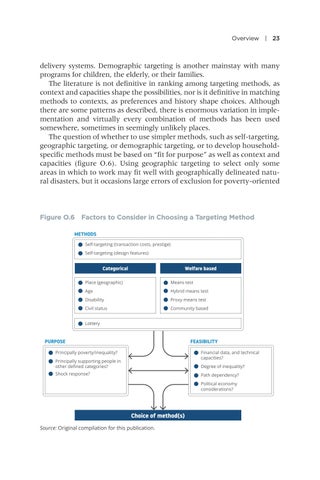Overview | 23
delivery systems. Demographic targeting is another mainstay with many programs for children, the elderly, or their families. The literature is not definitive in ranking among targeting methods, as context and capacities shape the possibilities, nor is it definitive in matching methods to contexts, as preferences and history shape choices. Although there are some patterns as described, there is enormous variation in implementation and virtually every combination of methods has been used somewhere, sometimes in seemingly unlikely places. The question of whether to use simpler methods, such as self-targeting, geographic targeting, or demographic targeting, or to develop householdspecific methods must be based on “fit for purpose” as well as context and capacities (figure O.6). Using geographic targeting to select only some areas in which to work may fit well with geographically delineated natural disasters, but it occasions large errors of exclusion for poverty-oriented
Figure O.6 Factors to Consider in Choosing a Targeting Method METHODS Self-targeting (transaction costs, prestige) Self-targeting (design features)
Categorical
Welfare based
Place (geographic)
Means test
Age
Hybrid means test
Disability
Proxy means test
Civil status
Community based
Lottery
PURPOSE
FEASIBILITY
Principally poverty/inequality?
Financial data, and technical capacities?
Principally supporting people in other defined categories?
Degree of inequality?
Shock response?
Path dependency? Political economy considerations?
Choice of method(s) Source: Original compilation for this publication.


